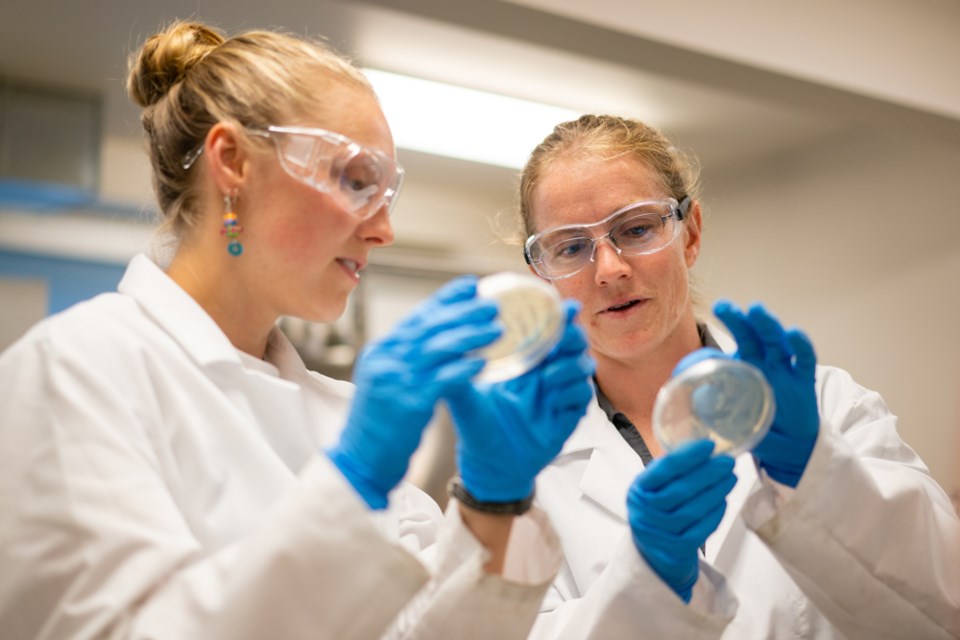Clean water is a global concern.
Ensuring access to clean water for everyone on the planet increasingly requires sophisticated systems to make less-than-pristine water potable, or at least usable.
A UVic professor and her research partners were recently awarded a $300,000 grant to ensure one popular system—reverse osmosis membrane technology (ROMT)—stays clean, safe and unclogged.
Heather Buckley, an associate professor of civil engineering and chemistry at UVic, explains that this type of filtration involves forcing water through a thin membrane that filters out contaminants or, in the case of ocean water, even salt. The challenge with such a system, she notes, is that microbes can grow on the surface of the membrane and fill its pores, causing the system to be less efficient—requiring more energy to push water through.
That’s called biofouling, and chlorine is typically used to kill the microbes that cause it. But Buckley says that comes with negative side-effects, forming harmful disinfection byproducts and damaging the RO membrane.
Buckley and the are partnering with—a Surrey, B.C. company that designs, manufactures and tests waste and water treatment systems—to develop sustainable, economical, safe chemicals that prevent the negative effects of biofouling in ROMT systems.
The goal is to help federal, provincial and municipal governments, First Nations communities, industry and remote work sites provide safe, reliable, sustainable water supply using ROMT.
While Buckley emphasizes that chlorination remains an effective water treatment to provide clean drinking water, she notes that using chlorine in ROMT systems also means there’s a dechlorination process as well.
“The dechlorination step is not particularly hazardous, but any time you’re using more steps and more chemistry, you have more waste, you have the environmental footprint associated with extracting and purifying those chemicals,” she explains. “So, we’re really thinking about this on a systems level: How can we bring something into the system that makes it safer for humans, that makes it safer for the environment and lowers the system-level footprint of what we’re doing?”
As well, because dealing with biofouling accounts for about 10 per cent of the cost of ROMT operation, a new solution is one step toward making plants more widely affordable.
The impact of the team’s research could be felt both locally and globally. For instance, about half of Israel’s water comes from unconventional sources, including reclaimed water and desalination, and there are remote communities around the world that struggle with unsafe and unsustainable water supplies.
“One of the huge pieces of this project that resonates for our research team is the environmental justice angle of recognizing that Canada has broadly failed its rural and northern First Nations with the sheer number of boil water advisories still in place, and the fact that’s often cited that technologies that could address that are too expensive.”
Buckley, who is also associate director of the, says the NSERC Alliance Missions research will run for two years and the goal is to produce several promising chemicals that BI Pure can pilot in the field.
In addition to the partner groups, she notes the crucial role of the PhD student leading the project, Luiz Da Silva Correa, and the efforts of master’s and undergrad co-op students who are involved under their collective mentorship.
UVic Green Save Water Lab
Other research underway by Buckley and colleagues at the UVic Green Safe Water Lab includes:
- Developing photodynamic antimicrobial surfaces and foul-release coatings: surfaces that prevent biofilm formation. These have potential applications in clinical, environmental and food packaging contexts.
- Exploring precious-metal-free materials for electrocatalysis. New composites could enable metal-air batteries, which are an attractive energy storage option because they have high theoretical energy densities and because they’re made without using precious metals.
- Designing and synthesizing materials for low-cost in-field detection of contaminants in water.
For more information on UVic research, visit .



